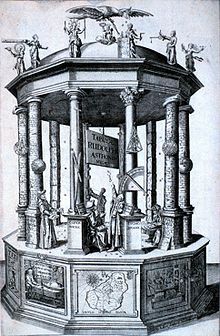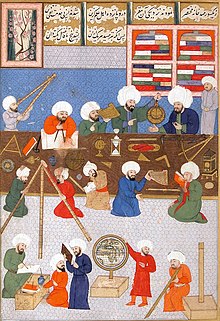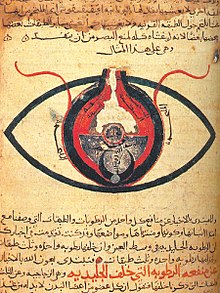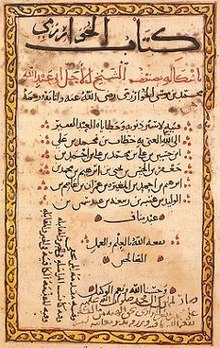中世纪伊斯兰世界的科学
| 科学史 |
|---|
 |
|

中世纪伊斯兰世界的科学即时通常所谓的伊斯兰科学、阿拉伯科学,是指中世纪的伊斯兰黄金时代(约750年至1258年)时伊斯兰世界发展出来的科学。在这段时期内印度、伊朗,特别是希腊的科学知识传入并影响到了伊斯兰文明的发展。[1]
伊斯兰文明内的科学发展有种族之别。贡献最多的是波斯人、[2][3][4][5] 阿拉伯人、[4] 摩尔人、亚述人和埃及人。他们的宗教背景各不相同,大多数属于穆斯林,[6][7][8]但也有基督教徒、[9] 犹太人[9][10] 和无神论者。[11][12]
“伊斯兰”一词即可以指伊斯兰教也可以指伊斯兰文明。[13] 虽然穆斯林的数量逐渐增长,但伊斯兰文明依旧是多信仰和多文化的。[14]
发展
[编辑]领域
[编辑]其他领域则包括:
著名科学家
[编辑]中世纪伊斯兰科学家之间交往密切,其研究也犹如同本之木。同时大多数的重要伊斯兰科学家都是通才,即所谓哈基姆(Ḥakīm),他们对伊斯兰科学的发展有举足轻重的影响。[15]
- 扎比尔·伊本·海扬(Jabir ibn Hayyan,约8-9世纪)是一位炼金术师,他的许多著作都流传到了今日。他描述了炼金术的实验技术及方法,发现了硫酸和硝酸等许多化学物质。除去已确定的著作外,还有许多著作被认为是由海扬所写。[16][17]

- 巴努·穆萨兄弟(Banū Mūsā,9世纪早期)是三位波斯占星师及天文学家, 他们与阿拔斯王朝哈里发马蒙关系密切,将很多古代世界的文献翻译成了阿拉伯文。他们阐释了圆锥和椭圆的数学原理,还发明了一些自动化设备。[18][19][20]

- 侯奈因·伊本·伊斯哈格(Hunayn ibn Ishaq,809–873)是最重要的古希腊语翻译家之一,是天主教聂斯托利派教徒,同时也是医生和作家,他的医学著作,特别是对于人眼的研究,在欧洲流行了数个世纪。[22]
- 阿拔斯·伊本·弗纳斯(Abbas Ibn Firnas,810–887)是一位安达卢西亚科学家、音乐家及发明家。他发明了用于制作器皿的透明玻璃、用于放大物体的透镜。他的房间里有模拟的天空,也曾试图发明飞行器。[23]

- 花拉子密(Muḥammad ibn Mūsā al-Khwārizmī,约8-9世纪)是一位波斯数学家、[25] 地理学家和天文学家。被认为是伊斯兰文明中最伟大的数学家。对阿拉伯数字的传播起着重要作用,他发展了伊斯兰代数学。[26]
- 拉齐(Muhammad ibn Zakariyā Rāzī,约854–925/935)是一位出生与伊朗的波斯通才,在医学上的贡献尤为显著,他识别出了天花和麻疹,发现了发烧是人体的自卫措施。他写出了23卷关于中国、印度、波斯、叙利亚和希腊数学的大纲。他对希腊的体液病理学及伽林的放血疗法提出了质疑。[28]
- 查尔卡利(al-Zarqali,1028–1087)是一位安达卢斯艺术家,是著名天文仪器制造人和数学家。他发明的星盘被后人沿用了数世纪之久。他也发明了水钟并发现太阳的远地点相对恒星有缓慢移动,并测出了其速率。[33][34]
- 穆罕默德·伊德里西(Muhammad al-Idrisial-Idrisi,1100–1166)是一位摩洛哥旅行家、绘图师和地理学家。以其为西西里的罗杰二世所绘的世界地图而为后人熟知。他也是《罗杰之书》的作者。[36]
基督教徒
[编辑]基督教,特别是聂斯托利派教徒在伊斯兰科学的翻译工作上有不可忽视的影响,[39] 这些人包括科学家古斯塔·伊本·鲁卡、帕特里克·提齐乌斯以及神学家他提安、巴戴桑、聂斯脱里等。[40][41]
评价
[编辑]关于伊斯兰科学在科学史中的地位,有许多不同观点:
以伯特兰·罗素为代表的传统观点[42] 认为虽然伊斯兰科学在许多方面都有建树,但是在发明上并不多,相对的是保存了许多古典文明的知识,并后来反过来传到了中世纪欧洲。一些持修正主义的学者,如阿卜杜勒·萨勒姆和乔治·萨里巴认为[43][44] 穆斯林科学在中世纪发生了重大革命。[45]
唐纳德·劳德利奇·希尔等学者认为伊斯兰教是伊斯兰科学之所以能够获得成功的潜在因素。[46] 艾哈迈德·达伦(Ahmad Dallal)认为中世纪伊斯兰科学“不仅对早期人类史甚至是当代人类史都有着重大影响”。[47]
托比·哈弗(Toby E. Huff)认为伊斯兰虽有许多发明,但并没能导致科学革命。[48][49]
威尔·杜兰特、[50] 菲尔丁·H·加里森[51] 和伯纳德·刘易斯认为穆斯林科学家在实验科学和科学研究方法上有重大贡献。
参考文献
[编辑]- ^ 1.0 1.1 Robinson, Francis. The Cambridge Illustrated History of the Islamic World edited by Francis Robinson. Cambridge University Press. 1996: 228–229.
- ^ William Bayne Fisher, et al, The Cambridge History of Iran 4, Cambridge University Press, 1975, p. 396
- ^ Shaikh M. Ghazanfar, Medieval Islamic economic thought: filling the "great gap" in European economics, Psychology Press, 2003 (p. 114-115)
- ^ 4.0 4.1 Ibn Khaldun, Franz Rosenthal, N. J. Dawood (1967), The Muqaddimah: An Introduction to History, p. 430, Princeton University Press, ISBN 0-691-01754-9.
- ^ Joseph A. Schumpeter, Historian of Economics: Selected Papers from the History of Economics Society Conference, 1994, y Laurence S. Moss, Joseph Alois Schumpeter, History of Economics Society. Conference, Published by Routledge, 1996, ISBN 0-415-13353-X, p.64.
- ^ Howard R. Turner (1997), Science in Medieval Islam, p. 270 (book cover, last page), University of Texas Press, ISBN 0-292-78149-0
- ^ Hogendijk, Jan P. (January 1999), Bibliography of Mathematics in Medieval Islamic Civilization (页面存档备份,存于互联网档案馆)
- ^ A. I. Sabra. Greek Science in Medieval Islam. Ragep, F. J.; Ragep, Sally P.; Livesey, Steven John (编). Tradition, Transmission, Transformation: Proceedings of Two Conferences on Pre-modern Science held at the University of Oklahoma. Brill Publishers. 1996: 20. ISBN 90-04-09126-2.
- ^ 9.0 9.1 Bernard Lewis, The Jews of Islam, 1987, p.6
- ^ Salah Zaimeche (2003), Introduction to Muslim Science.
- ^ Hogendijk 1989
- ^ Bernard Lewis, What Went Wrong? Western Impact and Middle Eastern Response
- ^ Lewis, Brenard. The Jews of Islam. Princeton University Press. 1987: 5–6.
- ^ Courbage, Youssef; Fargues, Phillipe. Christians and Jews under Islam. London: I.B. Tauris Publishers. 1995: ix–x. ISBN 1-86064-285-3.
- ^ Nasr, Seyyed. Science and Civilization in Islam. Harvard University Press. 1968: 41.
- ^ Masood, 2009, pp.153–55
- ^ Lagerkvist, Urf. The Enigma of Ferment: from the Philosopher's Stone to the First Biochemical Nobel Prize. World Scientific Publishing. 2005: 32.
- ^ Masood, 2009, pp.161–63
- ^ Lindberg, David. Science in the Middle Ages. The University of Chicago Press. 1978: 23,56.
- ^ Selin, Helaine (编). Encyclopaedia of the History of Science, Technology, and Medicine in Non-Western Cultures. Kluwer Academic Publishers. 1997: 151, 235, 375.
- ^ Masood, 2009, pp.49–52
- ^ Masood, 2009, pp.47–48, 59, 96–97, 171–72
- ^ Masood, 2009, pp.71–73
- ^ Masood, 2009, pp.48–49
- ^ Toomer, Gerald (1990). "Al-Khwārizmī, Abu Jaʿfar Muḥammad ibn Mūsā". In Gillispie, Charles Coulston. Dictionary of Scientific Biography. 7. New York: Charles Scribner's Sons. ISBN 0-684-16962-2.
- ^ Masood, 2009, pp.139–45
- ^ Masood, 2009, pp.74, 148–50)
- ^ Masood, 2009, pp.74, 99–105
- ^ Masood, 2009, pp.148–49
- ^ Masood, 2009, pp.104–5
- ^ Masood (2009, pp.108–109)
- ^ Masood, 2009, pp.173–75
- ^ Linton (2004), p.97). Owing to the unreliability of the data al-Zarqali relied on for this estimate its remarkable accuracy was somewhat fortuitous.
- ^ Masood, Ehsan. Science and Islam A History. Icon Books Ltd. 2009: 73–75.
- ^ Masood, 2009, pp.5, 104, 145–146
- ^ Masood, 2009, pp.79-–80
- ^ Masood, 2009, pp.110–11
- ^ Masood, 2009, pp.132–35
- ^ Hill, Donald. Islamic Science and Engineering. 1993. Edinburgh Univ. Press. ISBN 0-7486-0455-3, p.4
- ^ Rémi Brague, Assyrians contributions to the Islamic civilization (页面存档备份,存于互联网档案馆)
- ^ Britannica, Nestorian (页面存档备份,存于互联网档案馆)
- ^ Bertrand Russell (1945), History of Western Philosophy, book 2, part 2, chapter X
- ^ Abdus Salam, H. R. Dalafi, Mohamed Hassan (1994). Renaissance of Sciences in Islamic Countries, p. 162. World Scientific, ISBN 9971-5-0713-7.
- ^ (Saliba 1994,第245, 250, 256–257页)
- ^ Abid Ullah Jan (2006), After Fascism: Muslims and the struggle for self-determination, "Islam, the West, and the Question of Dominance", Pragmatic Publishings, ISBN 978-0-9733687-5-8.
- ^ Ahmad Y Hassan and Donald Routledge Hill (1986), Islamic Technology: An Illustrated History, p. 282, Cambridge University Press
- ^ Dallal, Ahmad. Islam, science, and the challenge of history. Yale University Press. 2010: 12. ISBN 9780300159110.
- ^ (Huff 2003)
- ^ Saliba, George. Seeking the Origins of Modern Science? Review of Toby E. Huff, The Rise of Early Modern Science: Islam, China and the West. Bulletin of the Royal Institute for Inter-Faith Studies. Autumn 1999, 1 (2) [2008-04-10]. (原始内容存档于2008-05-09).
- ^ Will Durant (1980). The Age of Faith (The Story of Civilization, Volume 4), p. 162–186. Simon & Schuster. ISBN 0-671-01200-2.
- ^ Fielding H. Garrison, An Introduction to the History of Medicine: with Medical Chronology, Suggestions for Study and Biblographic Data, p. 86
- Campbell, Donald (2001). Arabian Medicine and Its Influence on the Middle Ages. Routledge. (Reprint of the London, 1926 edition). ISBN 0-415-23188-4.
- d'Alverny, Marie-Thérèse. "Translations and Translators", in Robert L. Benson and Giles Constable, eds., Renaissance and Renewal in the Twelfth Century, p. 421–462. Cambridge: Harvard Univ. Pr., 1982.
- Hobson, John M. The Eastern Origins of Western Civilisation. Cambridge University Press. 2004. ISBN 0-521-54724-5.
- Hudson, A. Equity and Trusts 3rd. London: Cavendish Publishing. 2003. ISBN 1-85941-729-9.
- Huff, Toby E. The Rise of Early Modern Science: Islam, China, and the West. Cambridge University Press. 2003. ISBN 0-521-52994-8.
- Joseph, George G. (2000). The Crest of the Peacock. Princeton University Press. ISBN 0-691-00659-8.
- Katz, Victor J. (1998). A History of Mathematics: An Introduction. Addison Wesley. ISBN 0-321-01618-1.
- Levere, Trevor Harvey. Transforming Matter: A History of Chemistry from Alchemy to the Buckyball. Johns Hopkins University Press. 2001. ISBN 0-8018-6610-3.
- Masood, Ehsan. Science and Islam A History. Icon Books Ltd. 2009.
- Morelon, Régis; Rashed, Roshdi. Encyclopedia of the History of Arabic Science 3. Routledge. 1996. ISBN 0-415-12410-7.
- Phillips, William D.; Carla Rahn Phillips, Jr. Phillips. The Worlds of Christopher Columbus. Cambridge University Press. 1992. ISBN 0-521-44652-X.
- Sabra, A. I. (2000) "Situating Arab Science: Locality versus Essence," Isis, 87(1996):654–70; reprinted in Michael H. Shank, ed., The Scientific Enterprise in Antiquity and the Middle Ages," (Chicago: Univ. of Chicago Pr.), pp. 215–231.
- Saliba, George. A History of Arabic Astronomy: Planetary Theories During the Golden Age of Islam. New York University Press. 1994. ISBN 0-8147-8023-7.
- Turner, Howard R. Science in Medieval Islam: An Illustrated Introduction. University of Texas Press. 1997. ISBN 0-292-78149-0.
扩展阅读
[编辑]- Daffa, Ali Abdullah al-; Stroyls, J.J. Studies in the exact sciences in medieval Islam. New York: Wiley. 1984. ISBN 0-471-90320-5.
- Nader El-Bizri, 'A Philosophical Perspective on Alhazen's Optics', Arabic Sciences and Philosophy (Cambridge University Press), Vol. 15 (2005), pp. 189–218.
- Nader El-Bizri, 'In Defence of the Sovereignty of Philosophy: al-Baghdadi's Critique of Ibn al-Haytham's Geometrisation of Place', Arabic Sciences and Philosophy (Cambridge University Press), Vol. 17 (2007), pp. 57–80.
- Hogendijk, Jan P.; Abdelhamid I. Sabra. The Enterprise of Science in Islam: New Perspectives. MIT Press. 2003. ISBN 0-262-19482-1. Reviewed by Robert G. Morrison at [1]
- Hogendijk, Jan P.; Berggren, J. L. Episodes in the Mathematics of Medieval Islam by J. Lennart Berggren. Journal of the American Oriental Society. 1989, 109 (4): 697–698. JSTOR 604119. doi:10.2307/604119.)
- Hill, Donald Routledge, Islamic Science And Engineering, Edinburgh University Press (1993), ISBN 0-7486-0455-3
- Huff, Toby E. (1993, 2nd edition 2003), The Rise of Early Modern Science: Islam, China and the West. New York: Cambridge University Press. ISBN 0-521-52994-8. Reviewed by George Saliba at Seeking the Origins of Modern Science?
- Huff, Toby E. Science and Metaphysics in the Three Religions of the Books (PDF). Intellectual Discourse. 2000, 8 (2): 173–198 [2013-10-20]. (原始内容 (PDF)存档于2012-03-16).
- Kennedy, Edward S. The Arabic Heritage in the Exact Sciences. Al-Abhath. 1970, 23: 327–344.
- Kennedy, Edward S. Studies in the Islamic Exact Sciences. Syracuse University Press. 1983. ISBN 0-8156-6067-7.
- Morelon, Régis; Rashed, Roshdi. Encyclopedia of the History of Arabic Science 2–3. Routledge. 1996. ISBN 0-415-02063-8.
- Saliba, George. Islamic Science and the Making of the European Renaissance. The MIT Press. 2007. ISBN 0-262-19557-7.
- Nasr, Seyyed Hossein. Islamic Science: An Illustrated Study. Kazi Publications. 1976. ISBN 1-56744-312-5.
- Nasr, Seyyed Hossein. Science & Civilization in Islam 2nd. Islamic Texts Society. 2003. ISBN 1-903682-40-1.
- Suter, Heinrich. Die Mathematiker und Astronomen der Araber und ihre Werke. Abhandlungen zur Geschichte der Mathematischen Wissenschaften Mit Einschluss Ihrer Anwendungen, X Heft. Leipzig. 1900.
- Deen, S M. Science Under Islam: Rise, Decline, Revival. LULU. 2007 [2019-12-22]. ISBN 978-1-84799-942-9. (原始内容存档于2017-12-21).
- 电视
- BBC (2010). Science and Islam.
外部链接
[编辑]- 学术机构
- 其他
- "How Greek Science Passed to the Arabs"(页面存档备份,存于互联网档案馆) by De Lacy O'Leary
- Saliba, George. Whose Science is Arabic Science in Renaissance Europe?. [2013-10-20]. (原始内容存档于2008-01-15).
- Habibi, Golareh. Review article(页面存档备份,存于互联网档案馆), Science Creative Quarterly.
- Islam, Knowledge, and Science
- The Islamization of science or the marginalization of Islam
- Richard Covington, Rediscovering Arabic Science, 2007, Saudi Aramco World(页面存档备份,存于互联网档案馆)
